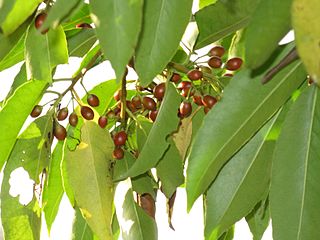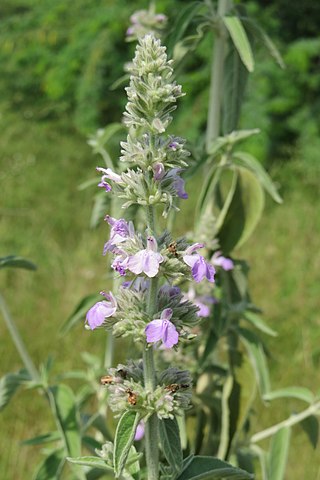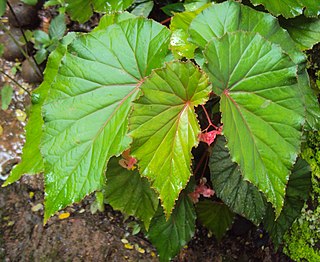
Ailanthus is a genus of trees belonging to the family Simaroubaceae, in the order Sapindales. The genus is native from east Asia south to northern Australasia. One species, the Tree-of-Heaven is considered a weed in some parts of the world.

Yerba maté or yerba-maté, Ilex paraguariensis, is a plant species of the holly genus native to South America. It was named by the French botanist Augustin Saint-Hilaire. The leaves of the plant can be steeped in hot water to make a beverage known as maté. Brewed cold, it is used to make tereré. Both the plant and the beverage contain caffeine.

Quercus ilex, the holm oak, also evergreen oak, is a large evergreen oak native to the Mediterranean region. It is a member of the section Ilex of the genus, with acorns that mature in a single summer.

Ilex opaca, the American holly, is a species of holly, native to the eastern and south-central United States, from coastal Massachusetts south to central Florida, and west to southeastern Missouri and eastern Texas.

Ilex vomitoria, commonly known as yaupon or yaupon holly, is a species of holly that is native to southeastern North America. The word yaupon was derived from the Catawban yą́pą, from yą- tree + pą leaf. Another common name, cassina, was borrowed from Timucua. The Latin name comes from an observation by early Europeans that the ingestion of the plant was followed by vomiting in certain ceremonies.

Ilex aquifolium, the holly, common holly, English holly, European holly, or occasionally Christmas holly, is a species of flowering plant in the family Aquifoliaceae, native to western and southern Europe, northwest Africa, and southwest Asia. It is regarded as the type species of the genus Ilex, which by association is also called "holly". It is an evergreen tree or shrub found, for example, in shady areas of forests of oak and in beech hedges. In the British Isles it is one of very few native hardwood evergreen trees. It has a great capacity to adapt to different conditions and is a pioneer species that repopulates the margins of forests or clearcuts.

Hopea is a genus of plants in the family Dipterocarpaceae. It contains some 113 species, distributed from Sri Lanka and southern India to the Andaman Islands, Myanmar, southern China, and southward throughout Malesia to New Guinea. They are mainly main and subcanopy trees of lowland rainforest, but some species can become also emergent trees, such as Hopea nutans.
Ilex ternatiflora is an extinct holly in the family Aquifoliaceae. It was endemic to a single location in Las Pozas in Pinar del Río Province, Cuba. It went extinct due to habitat destruction.

Polyalthia malabarica is a species of plant in the family Annonaceae and tribe Miliuseae. It is endemic to south-west India. It is threatened by habitat loss.

Phaeanthus is a genus of plant in family Annonaceae.

Ilex chinensis, the Kashi holly, oriental holly, or purple holly, is a species of flowering plant in the family Aquifoliaceae, native to Vietnam, southern China, Taiwan, and central and southern Japan.

Ilex or holly is a genus of over 570 species of flowering plants in the family Aquifoliaceae, and the only living genus in that family. Ilex has the most species of any woody dioecious angiosperm genus. The species are evergreen or deciduous trees, shrubs, and climbers from tropics to temperate zones worldwide. The type species is Ilex aquifolium, the common European holly used in Christmas decorations and cards.

Ilex mitis is a tall, dense, evergreen tree that is indigenous to Sub-Saharan Africa and Madagascar. It makes an excellent fast-growing hedge for gardens - growing tall, straight and dense.

Ilex cornuta, commonly known as Chinese holly or horned holly, is a slow-growing, densely foliaged evergreen shrub in the Aquifoliaceae plant family. It is native to eastern China and Korea and attains a height of about 3 metres (9.8 ft). The leaves are usually 5-spined, between 3.5 cm and 10 cm long, oblong and entire. The fruits are red berries, which are larger than those of the European Holly.

Anisomeles malabarica, more commonly known as the Malabar catmint, is a species of herbaceous shrub in the family Lamiaceae. It is native to tropical and subtropical regions of India, and Sri Lanka, but can also be found in Malaysia, Bangladesh, Myanmar, Bismarck Archipelago, Mauritius, Andaman Islands and Réunion.

Turpinia malabarica is a species of flowering plant in the family Staphyleaceae. It is an endemic tree species of the Western Ghats.

Eagle House is a Grade II* listed building in Batheaston, Somerset, near Bath. Before World War I the house had extensive grounds.

Ilex × attenuata, the topal holly, is the result of a cross between Ilex cassine (dahoon) and Ilex opaca. It is a naturally occurring hybrid found in the southeastern United States where the ranges of the parents overlap, but hybrid cultivars have also been created. The best known cultivars are 'Fosteri', Foster holly, which does not require males to set fruit, and 'Savannah', with very showy red fruit.

Ilex pedunculosa, called longstalk holly, is a species of flowering plant in the genus Ilex, native to central and southern China, Taiwan, and Japan. A lanky shrub or shrubby tree typically reaching 5 m (16 ft) in the garden, it is quite cold hardy. It gets its specific epithet and common name from its long peduncle. The red berries are relished by birds. It is deer resistant.

Begonia malabarica, the Malabar begonia, is a species of flowering plant in the family Begoniaceae, native to India and Sri Lanka. It has antibacterial properties.


















